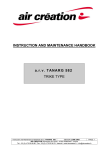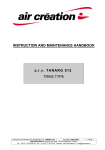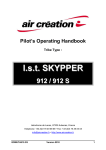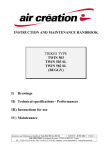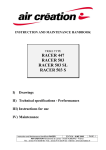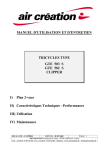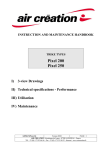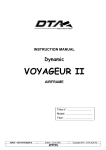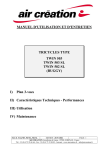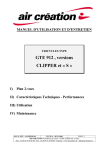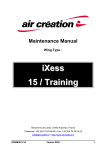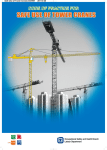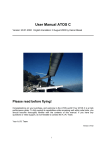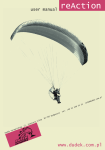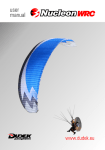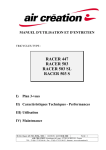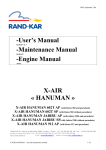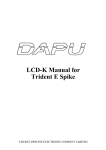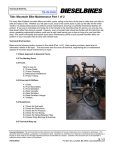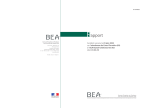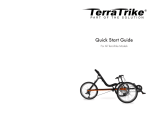Download GTE 912 SE / S type and CLIPPER
Transcript
INSTRUCTION AND MAINTENANCE HANDBOOK GTE 912 SE / S type and CLIPPER I) Drawings II) Technical specifications - Performances III) Instructions for use IV) Maintenance PAGE : 1 Instruction and Maintenance Handbook GTE 912 EDITION : JUNE 2005 AIR CREATION Aérodrome de Lanas - 07200 AUBENAS - France Tél. : 33 (0) 4 75 93 66 66 - Fax : 33 (0) 4 75 35 04 03 - Internet : www.aircreation.fr – [email protected] I) Drawings PAGE : 2 Instruction and Maintenance Handbook GTE 912 EDITION : JUNE 2005 AIR CREATION Aérodrome de Lanas - 07200 AUBENAS - France Tél. : 33 (0) 4 75 93 66 66 - Fax : 33 (0) 4 75 35 04 03 - Internet : www.aircreation.fr – [email protected] II) Technical specifications - Performances GTE 912 SE (S) CLIPPER 912 SE (S) Empty weight (Standard) 173 kg 381 lbs Maximum weight 397 kg - 877 lbs 397 kg - 877 lbs Ultimate load factors at max weight +6g -3g +6g -3g Limit load factors +4g -2g +4g -2g Fuel tank Capacity 15,85 US gal (60 l) 15,85 US gal (60 l) Rotax 912 Rotax 912 80 HP 80 HP 5800 rpm 5800 rpm Mechanical Mechanical 1/2.43 1/2.43 2386 rpm 2386 rpm Measured noise level Lm at max. weight - max. rpm 73 dB(72 dB) 73 dB(72 dB) Noise level corrected Lr 73 dB(72 dB) 73 dB(72 dB) 95 m 95 m 220 m (200 m) 220 m (200 m) Engine Max. power Max. rpm Reduction Drive Ratio Max. propeller rpm Height from ground H Minimum height from ground For a noise inferior to 65 db at Maximum power 181 kg - 399 lbs To calculate the Lh loudness heard on the ground when the aircraft flies at the h height at maximum weight and maximum rpm, use the following formula: Lh = Lr - 22 log h H PAGE : 3 Instruction and Maintenance Handbook GTE 912 EDITION : JUNE 2005 AIR CREATION Aérodrome de Lanas - 07200 AUBENAS - France Tél. : 33 (0) 4 75 93 66 66 - Fax : 33 (0) 4 75 35 04 03 - Internet : www.aircreation.fr – [email protected] III) Instructions for use a) Adapting wings and trikes Out of our current production, the wings XP 17, FUN 450, KISS 450 and iXess are the only ones to equip the GTE and CLIPPER 912 trikes. The propeller high position only allows assembling short keeled wings. To install a wing of another brand than AIR CREATION, check all parameters (height, displacement of the control bar, propeller clearance with keel end) and make sure that there is at least 10 cm clearance between the propeller and the wing structure, in all possible angles of attack and angles of bank with the hangpoint in its maximum forward position. b) Assembling • Lift the wing, rest it on its nose and into the wind. • Wheel the trike behind the wing, in the keel axis, take the windshield off, pull the upper beam down and take the front strut out. • Raise the upper beam, push the hang point into the hang bracket, position the Ø10 hang bolt, install the butterfly nut and the locknut, tilt the lever back in order to tighten the plates, and secure with the safety ring. • Slip the back-up fastening cable through the belt loop at the kingpost level, make one turn around it. Slip it through the belt loop again and fasten it to the trike upper beam. The back-up fastening cable should pass under the tensioning cables. This operation secures both the trike to the wing, and the wing crossbars tensioning system. • Place the propeller in horizontal position. • Raise the wing nose up to the horizontal. • Attach the front strut between the aluminum plates at the top of the upper beam using the bolt and the butterfly nut. • Hold the control bar and lift the wing while avoiding the trike to tilt and move backwards. The front strut can fit into the opening at the front of the upper beam once the wing is high enough. When operating solo, tilt the instrument panel back, sit down on the beam in front of the seat frame, face the A-frame; grab and lift the control bar to place it on your knees. Finally raise the wing to set the front strut. • Install the upper beam safety bolt on the engine support; screw the butterfly nut, tilt the lever back to tighten the plates, slide the safety ring into the bolt drilling. • Set the bolt connecting the front tube with the lower beam; screw the butterfly nut, secure with the split ring. • Install the foam seats using the Velcro® tabs. Roll the front parts of the rear bucket seat around the frame seat, before the middle strap of the under-seat, then fix these parts with Velcro® under the middle strap. Slip the Velcro® between the seat frame and the different wires. • Set into place the windshield of the panel by using the ¼ turn bolts. To disassemble reverse the assembly operations. Tilt the back of seat / container forward to the single-seater position before lowering the wing. PAGE : 4 Instruction and Maintenance Handbook GTE 912 EDITION : JUNE 2005 AIR CREATION Aérodrome de Lanas - 07200 AUBENAS - France Tél. : 33 (0) 4 75 93 66 66 - Fax : 33 (0) 4 75 35 04 03 - Internet : www.aircreation.fr – [email protected] c) Preflight checks • • • • • • • • • Check the wing as indicated in its operating manual. Check the trike-to-wing fastenings and every safety device. Check the front strut fastening on the upper and lower beams. Check the safety bolt of the upper beam onto the engine support. Check the propeller, the exhaust and its fastening springs, air filters and rubber mounts condition. Check the fuel filter, the fuel tank valve, and hose condition. Check the coolant level in the expansion tank, the oil level in the oil tank located at the back of the luggage container; be very careful with the rubber hoses and the hose clips. Make sure the grille of the water radiator coolant box is unobstructed; check the oil radiator and the fixations of the whole part. If you suspect any water to be in the fuel tank (condensation, fuel quality), get rid of it with the help of the emptying system located on the top of the tank, opposite to the cap. Use the fuel primer pump located in the pouch behind the pilot seat. Replace carefully the obstruction cap at the end of the emptying system afterwards. Make sure the sidebags, the back of seat / container and the luggage container are closed. d) Trike and engine operation − Foot Throttle Push the pedal to increase the power of the engine. Release the pedal to reduce it. − Hand throttle Push the throttle lever to increase the power. Pull it to reduce it. − Ground steering The steering bar operates the front wheel direction. Push on the right side with your heel : the aircraft will turn to the left, and vice versa. − Brake Push the left pedal forward to operate the brake upon the front wheel. − Ignition switch Down : ON Up : OFF − Fuel cock The fuel valve is open when the lever is set horizontally in comparison with the ground, in the direction of the fuel flowing. The fuel valve is closed when the lever is pointing vertically. − Starting • Fill the tank with premium gas (see the Rotax operator's manual for characteristics of the fuel). • Open the fuel valve. • Use the choke when the engine is cold. • Place the throttle lever and foot pedal in the "idle" position. PAGE : 5 Instruction and Maintenance Handbook GTE 912 EDITION : JUNE 2005 AIR CREATION Aérodrome de Lanas - 07200 AUBENAS - France Tél. : 33 (0) 4 75 93 66 66 - Fax : 33 (0) 4 75 35 04 03 - Internet : www.aircreation.fr – [email protected] Warning: A visual control of the throttle valves closure is necessary before starting the engine. Move the throttle lever back and forth to check that the lever on each carburetor returns to idle position. If you do not see any return move, the reason may be a wrong adjustment or the cables may be stuck. In these conditions, you may lose the control of the aircraft and cause a serious accident, due to the strong push after starting. • Lock the front wheel brake with the rack mounted on the pedal. • Set the ignition switch to "ON" with the interrupter located at the back of the box, under the hand throttle. • Make sure no one is standing close to the propeller and say out loud : "Clear prop" then turn the key of the master switch on the instrument panel to the third position to activate the electric starter. Immediately after engine start, let the key return to the second position (Activate starter for max 10 seconds only, followed by a cooling period of 2 minutes). • Turn the choke down when the engine has been running for a few seconds. • Adjust throttle to achieve smooth running at approx. 2500 rpm and check if oil pressure has risen within 10 seconds. • After the engine has come up to working temperature, test that the two ignitions work independently by reversing the contactor set in front of the switch breaker box (Central position = ignition 1 + ignition 2), under the hand throttle, engine running at 3000 rpm. Speed drop on each ignition circuit must not exceed 300 rpm. The difference between the two circuits must remain under 120 rpm . After the test, set the switch back to the central position 1+2. WARNING : Avoid a long-continued ground-run of the engine to prevent overheating due to lack of airflow wind particularly if the outdoor temperature is high. (See the Rotax operator's manual for more details about engine parameters). − • • • • • Inboard settling WARNING : an accident may occur while getting on board if the hand throttle lever is involuntarily moved forward. To eliminate this possibility, we recommend to get on board by the left handside of the trike and to be careful not to bump into the hand throttle on the right handside of the trike. The positions of the front fork and the passenger footrest are adjustable for everyone's comfort. Two holes situated on the lower beam of the trike allow for an adjustment of the fork and the pedals. For the passenger footrest, install the tube by positioning it above or under the lower beam. For dual control use, each modification in positioning the fork also involves changing the length of the dual control link tube with the appropriate holes set at the ends. For a single-seater use, the removable luggage bag can be placed instead of the passenger foam seat, held by straps and Velcro® fastenings. This bag is also usable as a back seat for the pilot, with the incorporated cardboard and rib. The load of the luggage bag set at the passenger place is limited to 25 kg (55 lbs.). It can be folded against the upper beam to be used as a back of seat for the passenger during two-seater flight. Step on the non-skid part of the lower beam in front of the seat frame to embark on the rear seat; do not use the dual control footrest. 4,5 lbs (2 kg) of varied tools can be placed in the pocket situated under the seat. The side bags have a carrying capacity of 11 lbs each (i.e. 5 kg each, material and luggage). The load capacity of the luggage container is maximum 9 lbs (4 kg). Check before each engine start that the door of the container and the oil tank cap are perfectly closed .A real danger exist due to the proximity of the propeller. PAGE : 6 Instruction and Maintenance Handbook GTE 912 EDITION : JUNE 2005 AIR CREATION Aérodrome de Lanas - 07200 AUBENAS - France Tél. : 33 (0) 4 75 93 66 66 - Fax : 33 (0) 4 75 35 04 03 - Internet : www.aircreation.fr – [email protected] − Prior to take-off • Check the fuel level in the tank and the opening of the cock. • Fasten and check seat belts. WARNING : Safety belts should be placed at hip level and tightened correctly. The strap loops under the seats are positioned to ensure correct safety belt positioning. Never remove safety belts from the strap loops under the seats: Safety belts fastened at abdominal level may cause internal injury in the event of violent shock. • When aircraft is equipped with shoulder's strap, pull the buckle to release the winding system and fix it on the locating lug provided for this purpose, on the belt's side. • Check ignition switch by rapidly switching OFF and then ON with engine operating. • Check that the switch selector is on the central position 1+2. • Check that the control bar moves freely in roll and pitch axis. • Check for engine normal working temperatures (see Rotax manual). • Release the parking brake by a short push on the brake pedal. − Take-off Use progressively full throttle when carrying a passenger. Throttle back slightly after having climbed 300 ft (100 m) to reduce engine wear. When flying solo, 3/4 throttle will be enough for take-off and climbing. Use full power only under critical conditions (short take-off runs, obstacles, high-altitude flight). In that case never reduce or cut the engine below the 300 ft (100 m) altitude to avoid dynamic stalling. For safety reasons, use the throttle lever rather than the foot pedal at take-off on rough terrain. Never take-off with less than 2.5 gallons petrol (10 l). The recommended speed for initial climb is indicated in the wing’s manual. − Cruising Keep the aircraft level with the throttle between 1/4 and full, depending on given airspeed. Avoid repeated and sudden power climbs and idle dives to prevent sudden engine temperature changes, which could damage the engine by thermal shock. Fuel tank content is easy to check from pilot’s and passenger’s seats as the tank is translucent and has a side gauge. Landing shall be considered before tank content has reduced to 1.5 US gallons (5 liters). This allows approximately 30 minutes reserve of flight at low cruising speed. − Landing The landing approach is best executed using the foot throttle pedal and both hands on the control bar. At maximum load, keep the throttle at 1/4 of full power when on final to facilitate flare-out. Throttle back when the wheels touch the ground. The recommended approach speed is indicated in the instruction and maintenance manual of the wing. To stop the engine, turn first the ignition switch to the "off" position and then the master switch on the instrument panel. Always remove the master switch after use to avoid any accident. − Parking Place the aircraft across the wind and place the extremity of the half-wing in the wind on the ground. Stop the engine with the ignition switch. Block the parking brake with the rack on the right side of the pedal. Block the control bar on the front strut of the trike using a Velcro®. Leave the trike, pilot first, then passenger, and always on the left side. Don’t move the propeller if you have not checked that the ignition switch is off because even a slow motion can cause the engine to start ! PAGE : 7 Instruction and Maintenance Handbook GTE 912 EDITION : JUNE 2005 AIR CREATION Aérodrome de Lanas - 07200 AUBENAS - France Tél. : 33 (0) 4 75 93 66 66 - Fax : 33 (0) 4 75 35 04 03 - Internet : www.aircreation.fr – [email protected] e) Emergency procedures − Power failure on take-off Should the power unit fail after take-off while still “at low height”, maintain aircraft control and safety approach speed, and land the aircraft straight ahead without attempting to turn back to the landing field. If time allows, set ignition switch off and fuel cock off. − Power failure at altitude If the engine fails for any reason, prepare for landing and carry out the emergency procedures as follow: • Maintain aircraft control. • Immediately establish the best glide angle speed. • Check for suitable landing sites. Choose a number of preliminary options if time permits. • Turn ignition key off. • Close the fuel cock. • Check pilot and passenger seat-belts are tight and secure. • Check wind direction, either by natural indications such as smoke rising or by judging drift of aircraft over the ground, wind on the water. • Choose the most appropriate landing site. • Set up an approach as accurate as possible into wind. • Remember your aircraft cannot be heard. Check that no one is on the landing site. • Finalize your approach, deciding upon the best landing free of any obstacles. • Use a short landing technique with safety. • Evacuate the aircraft as quickly as possible, inviting the second occupant to do the same. − Engine fire Should an engine fire occur during flight: • Maintain aircraft control • Maintain your flying speed. • Set fuel cock off. • Set ignition switch off. • Carry out the emergency landing procedures as above. f) Empty weight The standard empty weight which is used to calculate the reference empty weight of the whole aircraft does not include the options stated hereafter. So, think of taking from the useful weight indicated on the third page of the user's manual of the wing the weight of each option. PAGE : 8 Instruction and Maintenance Handbook GTE 912 EDITION : JUNE 2005 AIR CREATION Aérodrome de Lanas - 07200 AUBENAS - France Tél. : 33 (0) 4 75 93 66 66 - Fax : 33 (0) 4 75 35 04 03 - Internet : www.aircreation.fr – [email protected] g) Options available 1) Carburetor heater This option eliminates the risk of carburetor icing as it brings heated air, via the exhaust pipes, to the carburetors’ opening. The lever located on the front part of the seat frame and the carburetor temperature indicator allow precise control. Use the lever whenever the temperature on the indicator ranges between - 10° and +10 ° C, especially if the engine works at slow or idle speed and/or in humid atmosphere. The maximum engine speed is reduced by 400 rpm when the heater is active. The useful load of the trike is reduced by 2.9 lbs (2 kg) due to the weight of this option. 2) Parachute The trike can be equipped with a pyrotechnic rocket parachute BRS, under the engine. The parachute will slow the descent of both aircraft and occupants if a major problem occurs (collision, flight envelope exceeded, faintness etc.). It is advised to use it only as last solution to save life or reduce personal damages. Before starting the engine, the safety cotter pin placed on the launching handle should be removed. Then it should be replaced after landing, before going outboard, to avoid unintentional firing. It is recommended to link the engine key with the safety cotter pin, so its removal while using the trike cannot be forgotten. Before firing the parachute, it is advised, if altitude allows, switching the engine off to do not spoil the main bridle with the rotating propeller. If you cannot stop the engine, it will be stopped at the same time you pull the handle of the parachute, due to the switch integrated on the handle fitting. The activating of the rocket motor is made by pulling the red handle located between the pilot’s legs, on the seat frame. Warning: a strong pull on the handle is needed, at maximum available length. Always inspect bridle connection points and activation bridles before flying and must not be modified. When rigging the wing, bridles must be fixed with the link shackle. The recommendations concerning inspection, activation and unloading of the rocket, maintenance periods and overall care are stated in the user’s manual provided with the parachute. The parachute does not change the flight behavior of the microlight but its weight reduces the useful load by 22 lbs (10 kg). 3) Dual control for instruction This option allows for control of the ground steering and the engine power from the rear seat. For instructors, it allows full control from the rear seat of the aircraft. It reduces the useful load of the GTE trikes by 2.2 lbs (1 kg). PAGE : 9 Instruction and Maintenance Handbook GTE 912 EDITION : JUNE 2005 AIR CREATION Aérodrome de Lanas - 07200 AUBENAS - France Tél. : 33 (0) 4 75 93 66 66 - Fax : 33 (0) 4 75 35 04 03 - Internet : www.aircreation.fr – [email protected] 4) The "CLIPPER" Integral fairing When equipped with integral fairing, luggage container and streamlined struts, the GTE trike is named "CLIPPER". This model is very comfortable for long trips, the windshield giving a very efficient protection for the pilot due to the deflection of air flow while at high speed operations. The glide ratio is increased by 0.5 point and the max. speed by 3 mph (5 km/h). Landing distance is increased by 15 ft (5 m) due to these higher performances. The maximum useful load is 570 lbs (258 kg). The side bags can carry 2x 11 lbs (2 x 5 kg) of material; luggage container allows 9 lbs (4 kg). The procedure for rigging the wing changes with the Clipper trike. The windshield must be, at first, dismantled with a coin turning the Nylon screws a 1/4 turn. Once the wing is fixed on the upper beam, lift it from the front of the trike which should be held by someone else by the hub of the propeller or locked with a strap rolled around the front wheel to the ground. This will prevent the trike from moving backwards or falling over. Once the locking screws of the front tube and the safety screws of the upper beam are set on the engine mount, the windshield can be re-fitted. 5) Towing system The towing system reduces by 2.2 lbs (1 kg) the useful load of the GTE trikes. It allows streamers, advertising signs and hang glider towing. Pull the lever, set on the left lower part of the seat frame, backward to release the towing cable. PAGE : 10 Instruction and Maintenance Handbook GTE 912 EDITION : JUNE 2005 AIR CREATION Aérodrome de Lanas - 07200 AUBENAS - France Tél. : 33 (0) 4 75 93 66 66 - Fax : 33 (0) 4 75 35 04 03 - Internet : www.aircreation.fr – [email protected] IV) Maintenance a) Transport Trikes should preferably be transported on light trailers. Transporting the trike on a roof rack or in a van requires disassembling the rear undercarriage. b) Storage The trike unit should be thoroughly checked and cleaned prior to storage. After cleaning, wipe all components with a clean lightly oiled cloth, while avoiding joints and rubberized parts. If the trike unit is to be stored for a long period (e.g.:2-3 months): • See the Rotax Operator's manual for long time Engine storage. • Drain the fuel tank. c) Running in Your trike's engine has been factory-tested but requires running-in. The engine should be run in on the ground as stated in the ROTAX operator's manual. We recommend running in these engines in flight with no passengers, adhering as closely as possible to the ROTAX instructions. Except for take-off, avoid using full power for long periods during the first twenty-five hours. After this period change engine oil and filter and make a general check of the engine (See Rotax Operator's manual). d) Pitch of the propeller The pitch of the ARPLAST propeller can be adjusted according to the wing used and the air density. A maximum speed of 5400 rpm is recommended for all the wings, except for the iXess which needs a maximum of 5200 rpm in order to prevent over-revving at full speed. Use the special tool and the Arplast manual to modify the pitch. e) Long storage It is recommended to dismantle the trike sail in case of a long storage for several months. Fold it properly, in respect with its manual, to loosen the tensions and to protect it from ultraviolet. For the trike, you only need to place a cover or a sheet upon it and to prepare the engine according to the Rotax user's manual. Reverse the operation to use it and make a single-seater local flight test before using the aircraft as usual. f) Maintenance For the maintenance of your engine, refer to Rotax manual. NEVER FLY USING AN UNBALANCED PROPELLER (due to a shock or any projection). Vibrations generated will damage the reduction gear and the trike frame. To check propeller balance: remove the propeller and hang it, free to rotate (see your dealer), by the hub centre. If unbalanced, it should be returned to the factory for repair. Frequently clean the radiator grille of the air inlet as well as the radiator cooling box in order to avoid obstruction due to grass or debris. PAGE : 11 Instruction and Maintenance Handbook GTE 912 EDITION : JUNE 2005 AIR CREATION Aérodrome de Lanas - 07200 AUBENAS - France Tél. : 33 (0) 4 75 93 66 66 - Fax : 33 (0) 4 75 35 04 03 - Internet : www.aircreation.fr – [email protected] Every 10 hours of flight time : • • • • • • • Check trike, engine and propeller nuts. Check the exhaust system, the rubber mounts and the springs. Check air filters condition and attachments, carburetor heater and pipes if installed. Check oil level, topping up when necessary; check the condition of hoses, radiator and its mount. Check liquid coolant, water pipes condition, make sure air intake of radiator is clear. Check fuel filter condition/ cleanliness, attachments and ensure there are no leaks on fuel hoses. Check propeller condition. Every 50 hours of flight time : • • • • • • • • • Check the engine mounting silent blocks. Change the 2 front wheel shock absorbers. Check the beam where the engine is mounted and around the swivel joint for cracks or movement. Check seams on welded assemblies and mounting holes for movement (engine support, front fork, hooking frame point, upper beam swivel joint, radiator mount). Check rear shock absorber air pressure by exerting a lateral traction on the upper beam. Insufficient pressure will cause the trike suspension units to subside under load or lean excessively during turning on the ground or in cross-winds. Fill to 55 BARS using a special hand pump if needed (or see your dealer). Every 25 landings maximum, check the length of the sliding tubes of the « shock absorber »set. The difference (sets at full extension) should not exceed 2mm. If not, you should arrange for an overhaul. Moreover the overhaul of the “shock absorber” set has to be made every 250 take-off or every 3 years of use. Check condition and running of throttle and brake cables. Clean the air filters. Operate engine maintenance as indicated in the Rotax Operator's manual. Every 100 flight hours : • Change hoses, fuel filter and fuel primer bulb. • Change throttle and brake cables, all bolts involved in frequent mounting/dismounting operations (hangpoint, front strut, etc.), engine and propeller mounting bolts. • Check tires, rims, wheel bearings front fork and wheel axles. • Check engine support, hang point, undercarriage struts and links, wheel shafts and seat seams. • Check upper and lower mounting connections of front tube. Remove the upper and lower Nylon bases and inspect the tube where it enters the hole for ovalization or cracks. After any heavy landing : • Check the front fork, remove and inspect the fork pivot and wheel axis. • Check the seat frame and lower beam for distortion. Check seat seams. • Check the upper beam and the front strut, the swivel joint (movement, cracks), the engine support and the engine mounting rubber mounts. • Check the rear wheel assembly, loosening of assembly devices and shock absorber pressure. • The structure of the wing must be completely inspected in our premises or by an approved technical establishment after any heavy landing or even for slight damages. WARNING: Changing all NYLSTOP nuts after loosening is mandatory. Always secure such nuts using particular LOCTITE glue. PAGE : 12 Instruction and Maintenance Handbook GTE 912 EDITION : JUNE 2005 AIR CREATION Aérodrome de Lanas - 07200 AUBENAS - France Tél. : 33 (0) 4 75 93 66 66 - Fax : 33 (0) 4 75 35 04 03 - Internet : www.aircreation.fr – [email protected] PERIODICAL OVERHAULS BOARD Serial number : Date Hours flown Company which has carried out the overhaul address and stamp PAGE : 13 Instruction and Maintenance Handbook GTE 912 EDITION : JUNE 2005 AIR CREATION Aérodrome de Lanas - 07200 AUBENAS - France Tél. : 33 (0) 4 75 93 66 66 - Fax : 33 (0) 4 75 35 04 03 - Internet : www.aircreation.fr – [email protected] PERIODICAL OVERHAULS BOARD Serial number : Date Hours flown Company which has carried out the overhaul address and stamp PAGE : 14 Instruction and Maintenance Handbook GTE 912 EDITION : JUNE 2005 AIR CREATION Aérodrome de Lanas - 07200 AUBENAS - France Tél. : 33 (0) 4 75 93 66 66 - Fax : 33 (0) 4 75 35 04 03 - Internet : www.aircreation.fr – [email protected] Notes PAGE : 15 Instruction and Maintenance Handbook GTE 912 EDITION : JUNE 2005 AIR CREATION Aérodrome de Lanas - 07200 AUBENAS - France Tél. : 33 (0) 4 75 93 66 66 - Fax : 33 (0) 4 75 35 04 03 - Internet : www.aircreation.fr – [email protected] TRIKE - QUALITY FORM Anxious to ensure the perfection of our products, we have set a sequence of controls covering all the steps of production. We are working continuously on their improvement and we are in need of your help. Please return this reply form accurately filled if you find any mistake or problem concerning your trike, which could affect its quality or finish, even if it is a minor one. Your name, address and telephone number : Type : Delivery date : Trike number : Engine serial number : Distributor : Hours flown : Problems noticed : (explanations and / or drawing) ¼ PAGE : 16 Instruction and Maintenance Handbook GTE 912 EDITION : JUNE 2005 AIR CREATION Aérodrome de Lanas - 07200 AUBENAS - France Tél. : 33 (0) 4 75 93 66 66 - Fax : 33 (0) 4 75 35 04 03 - Internet : www.aircreation.fr – [email protected]
















